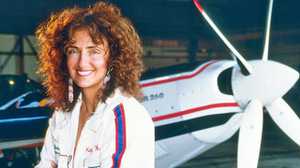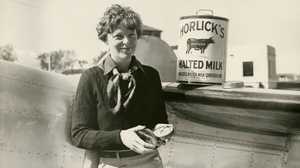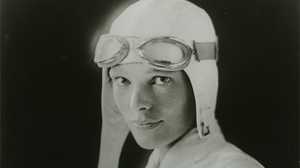Amelia Earhart, 1897-1937
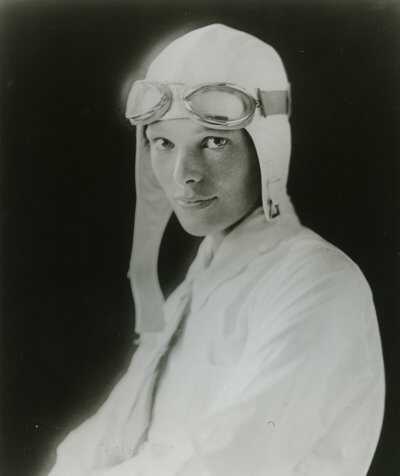
July 24, 1897: A 20th Century Childhood
Amelia Mary Earhart is born in Atchison, Kansas, to parents Amy Otis and Edwin Stanton Earhart. Her sister, Muriel, is born two years later.
Amelia lives primarily with her maternal grandparents in Atchison during the school year and spends summers with her parents in Kansas City. Despite her grandmother?s disapproval, Amelia spends her free time roaming the outdoors — riding imaginary horses, climbing trees, sledding, and hunting.
1908
Amelia rejoins her parents in Des Moines, Iowa. She sees an airplane for the first time at the Iowa State Fair and later recalls being unimpressed — “It was a thing of rusty wire and wood and looked not at all interesting.” It was not until a decade later, at a stunt-flying exhibition, that Amelia's passion for flight is awakened.
1910-1915
These are turbulent, difficult years for Amelia and her family. Amelia's grandmother, who raised her, dies in 1911. Her father struggles with alcoholism, losing his job and checking into a sanatorium for a month to rehabilitate himself. The family moves to St. Paul, Minnesota in 1913. When Edwin is again unable to recover and find a job, Amy leaves him and moves with Amelia and Muriel to Chicago.
June 1916: Amelia's Education
Amelia graduates from Hyde Park High School in Chicago. She excels in science, only enrolling at Hyde Park after determining that it had the best science program in the area. However, she has trouble making friends — her yearbook caption reads, “A.E. — the girl in brown who walks alone.”
Fall 1916-1918
Amelia attends the Ogontz School, an exclusive finishing school outside of Philadelphia. She again excels in her studies and becomes Vice President of her class. She does not graduate, however, choosing instead to volunteer at Toronto's Spadina Military Hospital as a nurse for wounded World War I soldiers.
While in Toronto, she attends a flying exposition with a friend. A stunt pilot dives at Amelia and her friend — “I am sure he said to himself, “watch me make them scamper,"“ Amelia later recalled — but Amelia stands her ground. She points to this incident as a personal awakening — “I did not understand it at the time, but I believe that little red airplane said something to me as it swished by.”
Fall 1919-1920
Amelia enters the pre-med program at Columbia University but after a year decides to leave to join her parents, who have reunited in Los Angeles.
December 28, 1920: Hooked on Flying
Amelia attends an air show on Long Beach with her father. With pilot Frank Hawk, she takes her first ride in an airplane. “By the time I had got two or three hundred feet off the ground, I knew I had to fly,” she later recalled.
January 3, 1921
Amelia has her first flying lesson with pilot Neta Snook. She works a variety of jobs — truck driver, photographer, stenographer — to save money for these lessons, and six months later is able to purchase her first airplane, a yellow Kinner Airster biplane she names the Canary .
December 15, 1921
Amelia passes her flying license tests given by the National Aeronautic Association. She flies in the Pacific Coast Ladies' Derby in Pasadena two days later.
October 22, 1922
Amelia sets an unofficial altitude record for female pilots after flying the Canary to 14,000 feet.
May 16, 1923
Amelia is issued an international pilot's license by the Fédération Aéronautique Internationale (FAI ), becoming the 16th woman ever to achieve this.
1924: Hiatus from Aviation
Amelia's parents divorce, and Amelia drives with her mother from California to Massachusetts where they move in with sister Muriel. Amelia goes to New York briefly to reenroll at Columbia, but she soon moves back to Boston where she works first as a teacher and then as a social worker at Denison House, teaching English to Syrian and Chinese immigrants.
1927
Amelia joins the Boston chapter of the National Aeronautic Association, and is occasionally featured in newspapers as an advocate for aviation and female pilots.
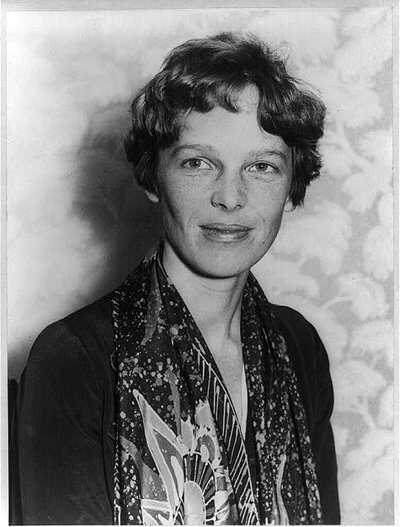
June 17-18, 1928: Overnight Stardom
Amelia Earhart, pilot Wilmer Stultz, and co-pilot and mechanic Louis Gordon depart from Newfoundland in the Friendship , a tri-motor seaplane. They arrive in Wales over 20 hours later and are greeted by cheering crowds.
Amelia does not think she deserves any acclaim for being the first woman passenger on a trans-Atlantic flight — “Stultz did all the flying — had to. I was just baggage, like a sack of potatoes.” She adds, “Maybe someday I'll try it alone.”
Summer 1928
Amelia's book about the Friendship flight, 20 Hrs. 40 Min. , is published. Amelia teams up with publicist George Putnam to write it, and he quickly promotes her to celebrity status. Amelia goes on a national book tour, endorses products like Lucky Strike cigarettes and Modernaire Earhart Luggage, and becomes known as “Lady Lindy” because of her resemblance to Charles Lindbergh. She also becomes Aviation Editor for Cosmopolitan magazine.
August 1929: Taking the Initiative
Amelia buys another airplane, a single engine Lockheed Vega. In the Vega, she participates in the Women's Air Derby race from Santa Monica to Cleveland, coming in third place.
November 2, 1929
Amelia helps found The Ninety-Nines, Inc., the first organization for women aviators. She will become its first president in 1931 and holds that position for two years, during which time she also uses her celebrity status to promote the growth of American commercial airlines.
July 5, 1930
Amelia sets the women's world flying speed record of 181.18 miles per hour. Between 1930 and 1935, Amelia will set seven women's speed and distance records.
February 7, 1931
Amelia Earhart marries George Palmer Putnam. Wary of the institution of marriage, Amelia refused George's proposals six times before she agrees. She will emphasize that her marriage is a “partnership” with “dual control.”
1932
Amelia writes her second book, The Fun of It .
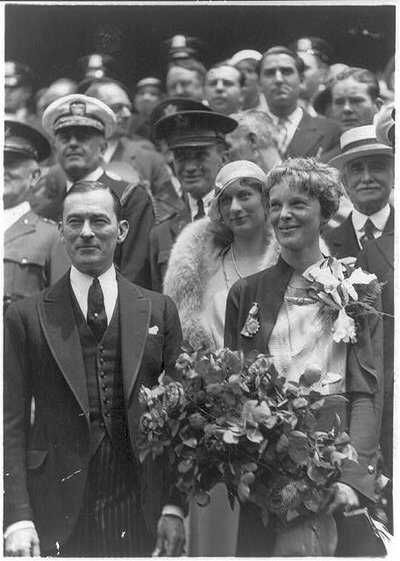
May 20-21, 1932: The Record Setter
Amelia Earhart becomes the first woman to fly solo across the Atlantic Ocean. She departs from Newfoundland and lands in a pasture in Northern Ireland.
This act earns her the Distinguished Flying Cross from Congress, the Cross of Knight of the Legion of Honor from the French government, and the Gold Medal of the National Geographic Society from President Hoover, becoming the first woman to ever receive this prestigious award. The site of her landing in Ireland now has a small museum, the Amelia Earhart Centre.
August 24-25, 1932
Amelia Earhart becomes the first woman to fly solo across the North American continent and back.
1933
Amelia visits the White House. From this visit she develops a friendship with First Lady Eleanor Roosevelt.
Amelia flies across North America for the second time, breaking her own record with a faster flight time.
1934
Amelia receives the Harmon Trophy for America's Outstanding Airwoman for the third year in a row.
January 11, 1935
Amelia is the first person to fly solo from Honolulu, Hawaii to Oakland, California. This year she will also fly solo from Los Angeles to Mexico City (April 19-20) and later from Mexico City to New York (May 8). In between flights she works as a career counselor to women at Purdue University.
July 1936: The Round-the-World Flight
Purdue University finances a new plane for Amelia, a Lockhead Electra 10E which she calls the “Flying Laboratory,” though the plane was purchase less for scientific research and more for Amelia's new dream: a “prize - one flight which I most wanted to attempt - a circumnavigation of the globe as near its waistline as could be.”
Amelia and her husband George Putnam plan for her world flight, raising money and consulting with advisers, mechanics, and navigators.
March 17, 1937
Amelia and her navigator, Fred Noonan, along with Captain Harry Manning and stunt pilot Paul Mantz, fly the first leg of the trip from Oakland, California to Honolulu, Hawaii in 15 hours and 47 minutes.
When they try to continue from Honolulu three days later, the plane ground-loops during take-off and they have to call off the flight.
June 1, 1937
Amelia departs on a second attempt, this time departing from Miami, Florida with the plan of traveling from west to east. Fred Noonan is her only crew member on this second flight. They complete nearly 22,000 miles of the flight, stopping in South America, Africa, India, and Lae, New Guinea.
July 2, 1937
Amelia Earhart and Fred Noonan depart from Lae. Their destination is Howland Island, a tiny island in the Pacific only 13,200 feet long and 2,650 feet wide. Amelia and Noonan cannot find the island, however, and they lose radio contact with the Coast Guard cutter Itasca , who can hear that they are lost but cannot return communication.
They disappear over the Pacific Ocean. President Roosevelt issues a massive search for Amelia and Noonan, and George Putnam finances his own search until October 1937, but their efforts are unsuccessful.
January 5, 1939
Amelia Earhart is declared legally dead in a court in Los Angeles.




